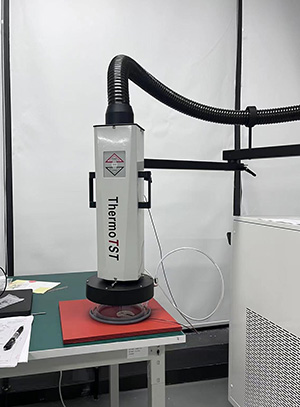Temperature Forcing Systems are aesthetically pleasing, compact, and portable compared to traditional test boxes. 10 inch hd color touch screen, man-machine interface, easy to operate. Detachable design facilitates maintenance or repair of the internal components of the equipment.
A complete test machine includes main engine, flexible air conveyor, arm, moving head, glass cover. The flexible air feeder is a well-insulated hose that connects the base unit housing to a glass cover (or custom test box) on the moving head. The flexible air feeder is a well-insulated hose that connects the base unit housing to a glass cover (or custom test box) on the moving head. Then test the function of the chip at different temperatures by injecting gas.
Key points to understand before using Temperature Forcing Systems:
1、Prepare software and hardware before use
In the environmental testing process of Temperature Forcing Systems, the required sample performance, test conditions/test procedures and test techniques, the technical performance of the test equipment used, and the structure of the equipment, especially the operation and performance of the controller, must be understood. Read the operation manual of the test device carefully to avoid abnormal operation of the test device due to incorrect operation, resulting in test sample damage and incorrect test data.
2、Choose a reasonable Temperature Forcing system
In order to ensure the normal conduct of the test, the appropriate test equipment should be selected according to the different conditions of the test product, according to the size of the test chip, choose the appropriate heat insulation glass cover. For in-line IC testing, performance changes caused by temperature shock can also be monitored in real time.
3、Place test samples correctly
The object under test (IC) is covered with a glass cup to isolate it from the surrounding environment, thus forming a relatively independent small confined space. Then through the injection of gas, for the whole PCB board to provide temperature environment or high and low temperature impact; If there are many components on a PCB board, you only need to impact a single IC with high and low temperature without affecting the surrounding components.



















